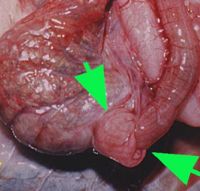Difference between revisions of "Lizard Enteritis"
Jump to navigation
Jump to search
| Line 1: | Line 1: | ||
| − | + | {{review}} | |
[[Image:Lizard_enteritis.jpg|200px|thumb|right|'''Intussusception may occur as secondary to enteritis''' (Copyright © RVC)]] | [[Image:Lizard_enteritis.jpg|200px|thumb|right|'''Intussusception may occur as secondary to enteritis''' (Copyright © RVC)]] | ||
| Line 7: | Line 7: | ||
'''Clinical signs''' include vomiting (grave prognosis) and diarrhoea. | '''Clinical signs''' include vomiting (grave prognosis) and diarrhoea. | ||
| − | '''Diagnosis''' - history, [[Lizard Physical Examination|physical examination]], faecal cultures, | + | '''Diagnosis''' - history, [[Lizard Physical Examination|physical examination]], faecal cultures, radiology, [[Lizard and Snake Haemotology|haematology]] and [[Lizard and Snake Biochemistry|biochemistry]]. |
'''Treatment''': | '''Treatment''': | ||
Revision as of 15:06, 18 May 2010
| This article has been peer reviewed but is awaiting expert review. If you would like to help with this, please see more information about expert reviewing. |
Enteric infections that result in clinical problems are, in general, uncommon. They can be associated with a bacterial pathogen, however this is not necessarily always the case. Indeed, enteritis is often related to poor husbandry, inappropriate diet, misuse of antimicrobials, parasites, stress and foreign bodies.
Clinical signs include vomiting (grave prognosis) and diarrhoea.
Diagnosis - history, physical examination, faecal cultures, radiology, haematology and biochemistry.
Treatment:
- Symptomatic therapy (e.g. kaolin)
- Increased dietary fibre (bran, hay, alfalfa pellets)
- Oral inoculation of parasite-free faeces from a healthy iguana
- Antibiotics based on sensitivity testing
- Supportive care with specific attention to hydration status.
